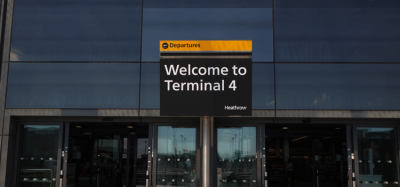Sustainable screening solutions
Posted: 4 April 2013 | Yves Duguay, Senior Vice President - Operations and Passenger Experience, CATSA | No comments yet
Today’s passengers want all possible security threats detected quickly and with minimal waiting time, while being treated like valued paying customers. Yves Duguay, Senior Vice President – Operations and Passenger Experience at CATSA, explains why it’s not as easy as it sounds.
Providing a quality security service is at the heart of what the Canadian Air Transport Security Authority (CATSA) strives to achieve. It has taken a decade for the corporation to build systematic and robust programmes to deliver this valuable service to the 51 million passengers who pass through Canada’s airports every year.
Today’s passengers want all possible security threats detected quickly and with minimal waiting time, while being treated like valued paying customers. Yves Duguay, Senior Vice President – Operations and Passenger Experience at CATSA, explains why it’s not as easy as it sounds.
Providing a quality security service is at the heart of what the Canadian Air Transport Security Authority (CATSA) strives to achieve. It has taken a decade for the corporation to build systematic and robust programmes to deliver this valuable service to the 51 million passengers who pass through Canada’s airports every year.
Having had the opportunity to work in the fields of public and private security, and most recently in aviation security with CATSA, I believe it will become increasingly difficult to sustain our current screening practices and performance standards without increasing costs and or building larger facilities. But this will undoubtedly impact the industry we serve and protect. Additionally, if we are not strategic we run the risk of alienating a travelling public that has been both supportive and patient since the events of 9/11. Consumers are more knowledgeable than ever – due in part to social media – and that means they are becoming less accepting of ‘one size fits all’ regulatory security measures.
CATSA has worked hard to limit the impact of passenger traffic growth and increasing operational costs by continuously improving its performance and stretching its resources. We have systematically measured and managed our operational performance, in alignment with a vigorous security system with the corporation’s stated objectives: passengers screened effectively, efficiently, quickly and courteously. But there is always room for improvement.
There are still a number of possibilities to explore, that could improve our performance, including:
■ Improving human performance through a more holistic training programme
■ Smarter deployment of resources, using more effective passenger forecasting tools
■ Better designed checkpoints that involve the automation of certain processes
■ Adopting risk-based security solutions, such as behavioural security and trusted passenger programmes.
But even with these additional improvements, we will soon reach a point where it will be extremely challenging to improve our performance without changing core elements and assumptions of the current regulatory regime. With the International Air Transport Association (IATA) forecasting a yearly passenger growth factor of five per cent until 2016, the compounded impact will be very challenging.
In this article, I will propose paths that our industry should explore to remain viable in the coming years. I will also share current best practices, such as the outcomebased approach that CATSA has adopted for its screening contracts, supported by a collaborative performance management programme – a key element of CATSA’s continuous improvement strategy.
CATSA is a federal Crown corporation created in 2002, and we have elected to deliver security screening services in Canada through a third party service model.
I am of the opinion that to sustain screening operations, stakeholders and regulators must work together to develop a risk-based model in which screening services are segmented based on the diverse needs of the travelling public. It’s no secret that most industries segment their services in order to meet their clients’ needs and preferences. I’m confident that security screening at airports can adopt a similar approach.
A good example in Canada is the NEXUS programme. NEXUS provides pre-approved, low-risk travellers with expedited customs and immigration processing when crossing the border between Canada and the United States. NEXUS cardholders can also access a dedicated entrance to our checkpoints, resulting in shorter waiting times and a modified security experience. This programme continues to see steady growth in membership – roughly 88 per cent since 2010.
In the last 10 years, passenger screening has evolved into a security service that’s integrated into the end-to-end customer experience. It has reached this point through the development of strategic alliances with key players in the supply chain. CATSA has learned a great deal by collaborating with its partners – airports and airlines. Although the Crown corporation keeps its security mandate top of mind, it has adopted the language of its partners, particularly in the area of performance management through operational data. It has also worked to be a better industry partner by understanding their concerns and pressures and identifying mutual goals; we don’t want to be a hurdle, we want to be a source of value.
As airlines and airports have made significant changes to their business models, leveraging technology to reduce costs and better tailor their services to the needs of their customers, CATSA has also had to adjust and evolve. After all, security screening is increasingly the first human interaction in a passenger’s travel experience.
Measuring and improving performance
By measuring different elements and processes of the security screening system, CATSA has been able to identify variations in performance and then drill down to identify root causes. To do so, CATSA created a capacity to measure and track effectiveness, efficiency and customer satisfaction, by combining operational security data and compliance observations (captured through a robust quality assurance programme at security checkpoints) along with the networking of screening equipment (e.g. x-ray, walk-through metal detectors, boarding pass security system), including the Boarding Pass Security System (BPSS).
CATSA’s BPSS is a prime example of how technological innovations can enhance both security and service to passengers. BPSS electronically validates boarding passes, and when combined with Closed Circuit Television (CCTV), offers a formidable tool to manage and mitigate security incidents at checkpoints, preventing at times the potential evacuation of airport terminals. It also generates waiting times and throughput data for specific checkpoints, allowing CATSA to track its service levels and share wait time information with both passengers and partners via websites or live in airport terminals.
In the spirit of true collaboration and transparency, CATSA has also entered into Memoranda of Understanding with airlines and airports in Canada to allow for the sharing of select BPSS data in keeping with Canadian privacy legislation. With this data an airline could ‘ping’ the BPSS database from the departure counter at the gate to determine if a passenger can be located at the checkpoint and decide whether or not to offload their guest and their checked baggage. Strict controls ensure that only airlines can retrieve information related to their own passengers. This cutting-edge tool also provides vital information to forecast passenger traffic and arrival patterns, allowing CATSA (and our stakeholders in given airports) to better align service at the checkpoint with passenger traffic demands. Finally, CATSA uses all its operational data to create a dashboard to track and report on the following key performance indicators:
■ Effectiveness – testing results, threat image projections (TIPs) and compliance data
■ Efficiency – costs per passenger, throughput, processing time
■ Customer satisfaction, as measured by wait time and surveys.
In 2011, CATSA procured new five-year screening contracts, designed to be outcome-based and performance driven. They include financial incentives directly linked to the performance indicators mentioned above. A formal and collaborative relationship framework supports the management of these contracts and sets out regular performance reviews.
With two years of data now under its belt, CATSA has seen steady progression and significant improvement in all of its performance indicators. Its most notable improvements include an increase in throughput of nearly 40 per cent as well as lower costs per passengers and higher levels of customer satisfaction. All of this has been achieved while CATSA has maintained its excellent track record of security effectiveness.
So having improved its overall performance through such programmes, where does CATSA look next to improve security, process passengers faster and most importantly to remain sustainable? There are at least three areas: human factors; checkpoint design and regulations.
Human factors
Excellence in screening is really about finding the right balance between detecting threats and passenger facilitation. Such balance requires the right combination of screening equipment, checkpoint configuration, operating procedures and most importantly, human performance. Recruiting and training the right personnel coupled with dynamic scheduling promise to yield benefits that, in my view, have yet to be fully explored.
In the past, CATSA and its screening contractors have hired individuals with a mindset associated with a more traditional segment of the security industry, as reflected in our current uniforms, which we are reviewing. CATSA has learned from partners, notably the International Forum of Security Screening Authorities, and as a result is working with its contractors to develop innovative recruiting tools. The goal is to attract the right individuals from the outset – those that have the correct combination of skills and competencies to help facilitate a shift toward a ‘security service culture’, supported with the right training and communication mix.
It is important for screening officers to understand that although threat detection is a priority, they must also pay attention to the factors that influence a passenger’s understanding and acceptance of security procedures. These factors include continuous flow from one procedure to another as well as the interaction between screening officers and passengers as they move through security. The themes of detection, flow and customer service must be integrated into all communications and training strategies in order to foster acceptance and bring out the changes we want to promote. It must also be supplemented with timely information that will enable screening officers to make good security service decisions and improve their individual performances.
The meaning of customer service must be communicated to screening officers in a simple and meaningful way. Making eye contact with passengers, greeting them with a smile, guiding them through the process, explaining procedures if necessary and wishing them a safe journey to their destination are all important elements of a courteous and professional security service. These simple social gestures can help transform ‘cold’ procedures into a meaningful security experience. Additionally, when screeners focus their attention on passengers, they are paying more attention to behaviour and this makes sense in a risk-based approach: customerfriendly security is good security.
Different functions at the checkpoint require different skills, and as in any profession, one must consider the human factor and recognise that screening officers, like any employees, excel in different areas. So it stands to reason that we should train on the basis of strengths and schedule officers based on their skills and preferences, notably to improve the flow at the checkpoint.
CATSA’s study of process flow at the checkpoint has allowed us to pinpoint choke points. The results highlight the importance of staffing certain positions, such as the x-ray station, with individuals who possess the right skills, competencies and the confidence to perform well at those key positions. CATSA is currently studying the profiles of top performers on x-ray to determine how best to recruit and train people in these positions. The same can be said for screening officers who have strong customer service and facilitation skills – they are often the best suited to be the first point of contact for passengers in the queue, especially during peak periods.
Checkpoint design
Where does the current look and feel of our checkpoints come from? I suspect that over the years, it has been heavily influenced by the industry’s response to both actual and attempted terrorist attacks.
But what if we could start anew, focusing on securing and clearing passengers for travel, rather than looking for threat items and prohibited articles? What if screening, at the checkpoint itself, was only one source of security value in the entire process? With the assistance of cutting-edge technologies, we could even start screening passengers before they get to the checkpoint and then search passengers in one stream and their bags in another, where:
■ Pre-checkpoint screening activities would identify passengers with different security needs
■ Carry-on baggage could be reconciled with passengers through technology such as Near Field Communication (NFC), smart bag tags and CCTV
■ Carry-on bags could be screened rapidly using new or improved technologies (high-speed computerised tomography (CT), or combinations of technologies) by screeners in a remote location, similar to hold-baggage screening
■ Screening officers with greater customer service skills could be assigned to screening passengers in a separate stream (supported by advanced explosive detection technologies), while speciallytrained officers could observe passengers for suspicious behaviour.
There’s no limit to how much the delivery of this service can be improved, which is why CATSA is actively working with Canadian airports, the Transportation Security Administration (TSA), IATA and other industry experts (e.g. airport architects and planners) to design future checkpoints. In addition, CATSA is investigating how it can leverage technology to automate repetitive and monotonous tasks, in order to increase compliance and reallocate human resources to screening passengers and bags. Some of these areas of interest include the automated capture of wait times, random selection and automated entry to NEXUS lines.
Airlines and airports have used innovation and technology extensively over the last few years to increase passenger satisfaction and efficiency, and this approach has paid off. CATSA recognises this as a best practice and is adopting the same approach to further enhance its service delivery model. Only by questioning the status quo, promoting innovation and piloting new ideas can an organisation continuously improve.
Risk-based security
I believe that passengers won’t support a system that applies security measures to them indiscriminately for much longer. We must find innovative and sustainable solutions for screening services – particularly in the face of traffic growth and increased costs – by providing a service that can be tailored to different passengers, while still delivering on the security imperatives of our mandate.
Each year, CATSA screens over 51 million passengers in Canada, yet the number of recorded incidents account for less than .001 per cent of passengers screened. The probable is usually what happens and in operations, we manage the probable every day and guard against the possible. I believe we can deliver a better mix between what is probable and possible. Moreover, regulations and standard operating procedures (SOPs) are often developed in reaction to previous incidents and inspired largely by the International Civil Aviation Organization conventions.
Screening officers are trained to use SOPs to process all passengers in the same way. This is a blanket approach to security that is promoted by most regulators. However, this approach is ultimately not effective, both from a security and a facilitation perspective, as most passengers do not constitute a threat even if they are carrying a prohibited item like a small knife or a 200ml bottle of liquid. I personally cringe each time we screen our Minister of Transport or the CEOs of airports and airlines as if we didn’t know or trust them!
Of course, the challenge for regulators and operators is how to determine the risk factor associated with each passenger and apply the appropriate level of security while at the same time ensuring consistency across the operations. NEXUS – and other programmes such as Global Entry, SENTRI, and FLUX – offer solutions to resolve this dilemma. Passengers (most often seasoned travellers) voluntarily submit personal information in exchange for a security clearance that would give them access to a special line. The additional value inherent to these programmes should allow us to adjust and even reduce other screening procedures substantially.
In line with our desire to match passengers’ needs with our services, CATSA is currently working with airport authorities in Edmonton, Halifax and Toronto as well as associations representing passengers with special needs to offer a pre-notification service. For example, a passenger with an ostomy pouch or travelling with a guide dog could voluntarily advise CATSA in advance of their arrival at the checkpoint. In turn, CATSA would notify its screening providers to ensure screening officers are well prepared (and supported by adequate supervision) to provide the best security service possible, tailored to the passengers’ needs.
The final analysis
When we work in close collaboration with our industry partners and share the mutual goals of processing passengers efficiently, effectively and courteously, the possibilities to evolve and adapt today’s aviation security services are endless. But in order for innovation to flourish, we have to let go of the concepts and assumptions that have guided us in the past and embrace change. We live and operate in a very complex and uncertain environment where total security simply cannot exist. We have to assume some risk, so let’s do so smartly.
I am extremely encouraged by the recent actions and the overall direction taken by the TSA in that regard, and I feel that they may become the catalyst to promote a true riskbased security approach.
Dorner Dietrick, Professor Emeritus at the Institute of Theoretical Psychology at the Otto Friedrich University in Germany, wrote in The Logic of Failure that one must promote the development of common sense through a process of “systemic thinking” whereby the focus needs to be on proposing, challenging and always testing new ideas. I believe that if common sense, ongoing collaboration and ensuring passengers’ needs are at the forefront of what we do every day, we will achieve a successful holistic operation.
The tasks we face as an industry are not for the faint of heart and the challenges are great, but we have talented people who can meet these obstacles head on, especially if we work together and continue to build on our strong partnerships and strategic alliances.
Biography
As Vice-President of Operations and Customer Experience, Yves Duguay MBA oversees all passenger, non-passenger and hold baggage security screening at Canada’s 89 designated airports as well as championing efforts to enhance customer service. Before joining CATSA in 2007, Yves held senior leadership roles with the Royal Canadian Mounted Police and Air Canada. After six years of leading the operations, he will be leaving CATSA at the end of March 2013 to pursue new opportunities of interest. This article represents Yves’ personal views and not necessarily those of CATSA.
Are you ready to meet the expectations of Gen Z travellers? Join our virtual panel to discover how airports can engage the next generation of passengers.
16 Oct 2025 | 14:00 PM BST | FREE Virtual Panel Discussion
Join us for this interactive session where industry leaders will explore how airports are adapting to the needs and values of Gen Z, the first truly digital-native, socially conscious, and tech-savvy generation.
What You’ll Learn:
- What drives Gen Z travel decisions, and how to respond
- How to harness digital tools, social media, and mobile-first strategies
- How sustainability, inclusivity, and personalised experiences shape Gen Z’s airport expectations
- Real-world examples from leading airports that are successfully engaging younger travellers
Don’t miss your chance to learn from the airports leading this change – Register Now – It’s Free!


















